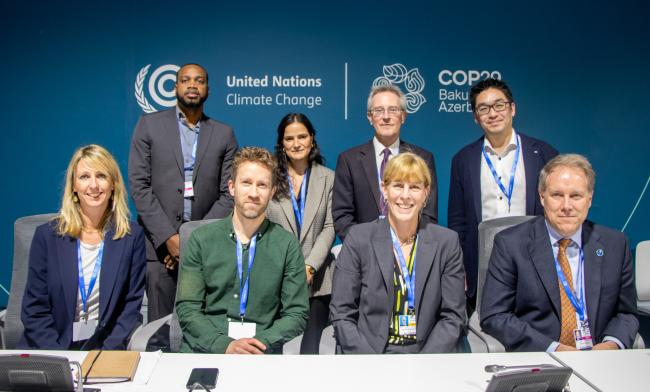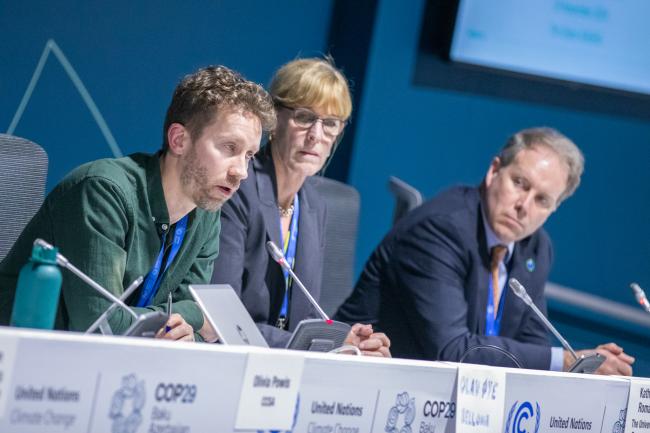About
With Carbon Capture and Storage (CCS) technologies increasingly coming online, policy experts, researchers, and partner organizations discussed the financial and technical support needed to scale them up.
Carbon capture and storage (CCS) technologies require financing, especially in developing countries, to unlock their potential to reduce greenhouse gas (GHG) emissions. At this event, researchers and CCS industry experts presented examples of how financing for CCS can bring these technologies online in emerging economies
The event was moderated by Tim Dixon, General Manager and Director, IEA Greenhouse Gas R&D Programme (IEAGHG). In his opening remarks, Brad Crabtree, Assistant Secretary, Office of Fossil Energy and Carbon Management (FECM), Department of Energy, US, noted the growing number of CCS projects around the world, with 50 in operation and another 600 in various stages of planning. He pointed to tax incentives in the US that are encouraging new projects and potentially reducing the cost of CCS projects in other parts of the globe. Crabtree noted that progress on Paris Agreement Article 6 negotiations also could help new projects take root.
Dixon offered a primer on CCS, noting it involves various technologies and methods for sequestering carbon from point sources such as power plants or through direct removal from the atmosphere. Dixon said current and planned CCS projects are not enough to achieve a net-zero pathway and urged changes in regulatory frameworks to create environments that are amenable for CCS technologies.
Katherine Romanak, University of Texas at Austin, presented research on the safety of CCS, explaining that carbon is sequestered more than 800 metres below the surface. Romanak pointed to testing and monitoring of carbon storage, saying that it shows the technology is “extremely safe, durable and secure.”
Olivia Powis, Chief Executive Officer (CEO), Carbon Capture and Storage Association, offered an overview of the UK’s strategy to bring CCS online, which involves a cluster strategy and regulatory programme aimed at long-term deployment. CCS clusters in industrial areas enable the sharing of infrastructures. She noted that carbon is stored offshore and that there is more capacity for storage than the UK requires, which means there is a potential for storing carbon produced in other countries. Powis underscored that the UK approach is aimed at moving toward a market framework through a long-term allocation framework providing certainty and competition, evolving business models, and enabling cross-border agreements.
James Fann, President and CEO, International CCS Knowledge Centre, highlighted his organization’s work to help accelerate deployment of CCS projects. Fann pointed to provincial and federal support through programmes and initiatives, such as investment tax credits and the Alberta Technology Innovation and Emissions Reduction Regulation (TIER), that produce a variety of support mechanisms for organizations in the CCS space with different needs. Fann emphasized the importance of knowledge sharing so new entrants in the space can learn the lessons from previous projects.
Olav Øye, Bellona Environmental Foundation (Bellona), emphasized the need for policy frameworks, such as the EU’s Net-Zero Industry Act and Emissions Trading System, that create incentives and send positive signals for industries to implement CCS.
Clarine Ovando-Lacroux, UN Environment Programme Copenhagen Climate Centre (UNEP-CCC), offered an overview of Trinidad and Tobago’s Technology Needs Assessment (TNA) launched in 2021, which identified CCS as a technology that can be a significant contributor to climate mitigation. Ovando-Lacroux noted that barriers to the adoption of CCS include high capital costs, limited data for cost estimates, regulatory hurdles, limited storage capacity, and low public awareness. She pointed to a variety of measures to address these barriers, including developing a framework for long-term CCS storage liability, updating legislation to include CCS pipelines, and strengthening coordination between key entities.
Donneil Cain, Caribbean Community Climate Change Centre (CCCCC), highlighted the organization's work to enable Green Climate Fund funding to Trinidad and Tobago and Suriname to develop CCS projects. This involves, he detailed, a country-driven approach that includes capacity building, strategic frameworks, and knowledge sharing, which will produce outputs in the form of, inter alia, revised National Determined Contributions (NDCs), development of tracking systems, and building partnerships to share best practices. Cain emphasized that what is needed to scale up CCS includes a trusted system to verify finances and emission reductions.
Answering questions from the audience, panelists noted, inter alia, that:
- it still unclear what the new US presidential administration will mean for US support for bilateral agreements on CCS but that Republicans have voiced support for continuing domestic tax policies that incentivize CCS
- CCS is one of many mitigation solutions;
- financial mechanisms other than expensive direct subsidies, such as carbon credit trading systems, may be needed in developing countries to scale up CCS; and
- progress on Article 6 could help bring down the cost of CCS.
Organizers: University of Texas at Austin, IEAGHG, Bellona, CCSA, International CCS Knowledge Centre
Contact: Tim Dixon | Tim.Dixon@ieaghg.org
Website: https://ieaghg.org/
To receive free coverage of global environmental events delivered to your inbox, subscribe to the ENB Update newsletter.
All ENB photos are free to use with attribution. For this side event, please use: Photo by IISD/ENB | Matthew TenBruggencate











